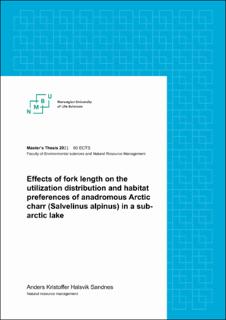| dc.description.abstract | This was an acoustic telemetry study investigating lacustrine habitat utilization of anadromous population of Arctic charr (Salvelinus alpinus) located in Storvatnet in Hammerfest multiplicity northern Norway. Arctic charr’s lacustrine habitat use lacks knowledge, and the aim of the study was to determine whether size-dependent effects occurred between habitat use in different seasons, and to find out to which extent the Arctic charr utilizes a part of the habitat that is planned to be filled out.
60 individuals of arctic charr were tagged with acoustic transmitters, and gently set back into the water where they were caught. These transmitters were constantly sending signals to a network of 13 receivers constantly logging signals from the transmitters. The signals were made into detailed position data revealing the position of the fish in the lake throughout the study period.
The results revealed differences in utilization distribution between different seasons. There was also a size-dependent effect for some of the seasons. The larger individuals had a low activity during the winter, a high activity in the spring, which continued into the summer before they migrated into the sea. When they came back in the fall they had a low activity, which continued through the spawning season. The smaller individuals also had a low activity during winter, and a high activity in summer, but for spring and fall the tendency was opposite of the larger ones, with low activity in spring, and high activity in autumn.
There was overlap between utilization distribution and filling area during all seasons, and for all sizes of fish. The probability of overlap was highest in the spring, and in this season increased with decreasing fish size. The probability was nevertheless relatively low for all sizes of fish and for all seasons peaking at about 25% probability for the smallest individuals in spring.
Due to the bad coverage of signals along the edge of the lake system, it is difficult to say whether if the findings on overlap are trustworthy. The fact that there is no research done on effects of filling on reproductive success of anadromous arctic charr, makes it even more difficult to predict to which extent the population will be affected by the filling. Further research on this topic is therefore recommended. | en_US |

